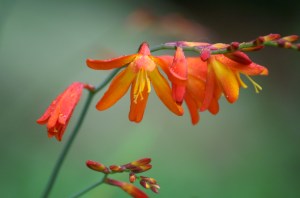
Most of all, he enjoyed pruning the Japanese maples.
They stood beneath the canopy of evergreens–spruce, pine, fir, cedar, cypress–the giants of his garden. The tall conifers took the brunt of the weather, snarling into the winds, sacrificing muscular branches heavy with sap and resined scent to protect the more delicate growth at their feet. There was little to prune on these living towers; mostly he just carted away what the ocean-birthed storms snapped off, trimming back broken stubs, fulfilling his custodial chores while they, aloof and inscrutable, heads in the louring clouds, faced the southwesterly winds, ready for the next gale.
The other maples, the vine maples, were not his favorites, being a bit too boisterous, sending up trunk after slender trunk, reaching outward with multiplicative hands, begging for alms of sunlight. Pruning these, even the eldest of them, was like wrangling twelve-year-olds on a class trip. Just retrieve the one and you find that two others have ranged away from the pack. He loved them for their fall displays, though; their sudden, explosive shift from simple summer green to riotous fires of autumn could happen during a single night’s slumber. He was especially fond of the precocious one in the back, tucked under the pendant drapery of the grandmother spruce, because that maple was always first to change clothes, eager for colorful sweaters and winter’s onset.
But most of all, he enjoyed pruning the Japanese maples. Not the winter’s pruning, but in summer.
In winter, when they slept naked beneath the grey blankets of somnolent skies, he would trim them for shape, for strength, for optimal overlap and layering, and with an eye toward the tripartite growth that would come in spring. This, though, this was straightening the curled hand of a sleeping child, tucking them in beneath the covers. It was the trees, and it was him; two species, separate, unattached, isolate.
In contrast, the summer pruning–he could think of no other metaphor–was making love. The leaves of the Bloodgood–deep magenta, finely serrated, with thin, questing tips–rustled as his hands moved through the branches. The Autumn Moon’s leaves–pale green, delicate, so sensitive to light that a week’s sun would make them blush and August’s searing gaze could shrivel whole branches–bent to his ministrations, be it to rub out the dried tip or snip off a sere frond.
The two of them, though they were as old as others he’d planted, were barely half as tall. Theirs was a patient habit, a measured expansion, with each branch testing the world in three directions: one twig right, one left, one forward and upward. As his fingertips moved down each limb, each branch, each twig, he could divine their logic. They knew their limits and worked within them: send out scouts, read the reports, proceed only if conditions are favorable. He loved their caution to the point of emulating their unhurried approach in his own life. Knowing that his eyes could sense things they could not, knowing where the dappled sunlight would be best, he would pinch here, pluck there, and encourage them toward the unseen goal. Of their failures, his gentle caress revealed the abandoned twigs, stiff and pale where successes remained supple and green, and he would thumb them off. The snips were a last resort, for each leaf was a gem in the rough.
For when Summer packed its bags and Autumn came home to do its laundry, the evergreens remained dark and disinterested columns and the vine maples played frat-boy pranks on one another. But between the constancy and the chaos was the slow flood of color of his Japanese maples. The Bloodgood’s leaves crept from maroon to red to rust to scarlet to a crimson so sharp it could cut, while the Autumn Moon caught fire, dropping green for chartreuse, adding dry-brushed pinks, until October’s cold hearth brought the touch of orange hearthfire to each leaf.
He was aging, now, knees creaking, back growing stiff, while for these trees their youth was barely begun. He wondered–frankly, he worried–about what would happen to them once he’d passed. “Scatter my ashes on my trees,” he’d often say, though he only dreamed he would die while still near them. For as long as he could, he would remain there, caring for them at the same tempo they lived.
Because, most of all, he enjoyed pruning the Japanese maples.
k

Read Full Post »
 Walking my garden paths
Walking my garden paths





 Last week, I stood out in the rain.
Last week, I stood out in the rain.

 Late winter is my “difficult” season. Maybe it’s Seasonal Affective Disorder. Maybe it’s the combination of allergies and holiday letdown. This year, it’s also the ongoing can’t-look-away train wreck that is our electoral process. Either way, I’ve been depressed and unmotivated for the past couple of months.
Late winter is my “difficult” season. Maybe it’s Seasonal Affective Disorder. Maybe it’s the combination of allergies and holiday letdown. This year, it’s also the ongoing can’t-look-away train wreck that is our electoral process. Either way, I’ve been depressed and unmotivated for the past couple of months. Unraveling Time
Unraveling Time Desert Wind
Desert Wind Ploughman's Son
Ploughman's Son Ploughman King
Ploughman King The Year the Cloud Fell
The Year the Cloud Fell The Spirit of Thunder
The Spirit of Thunder Shadow of the Storm
Shadow of the Storm The Cry of the Wind
The Cry of the Wind Beneath a Wounded Sky
Beneath a Wounded Sky Cryptogenesis: A Memoir
Cryptogenesis: A Memoir